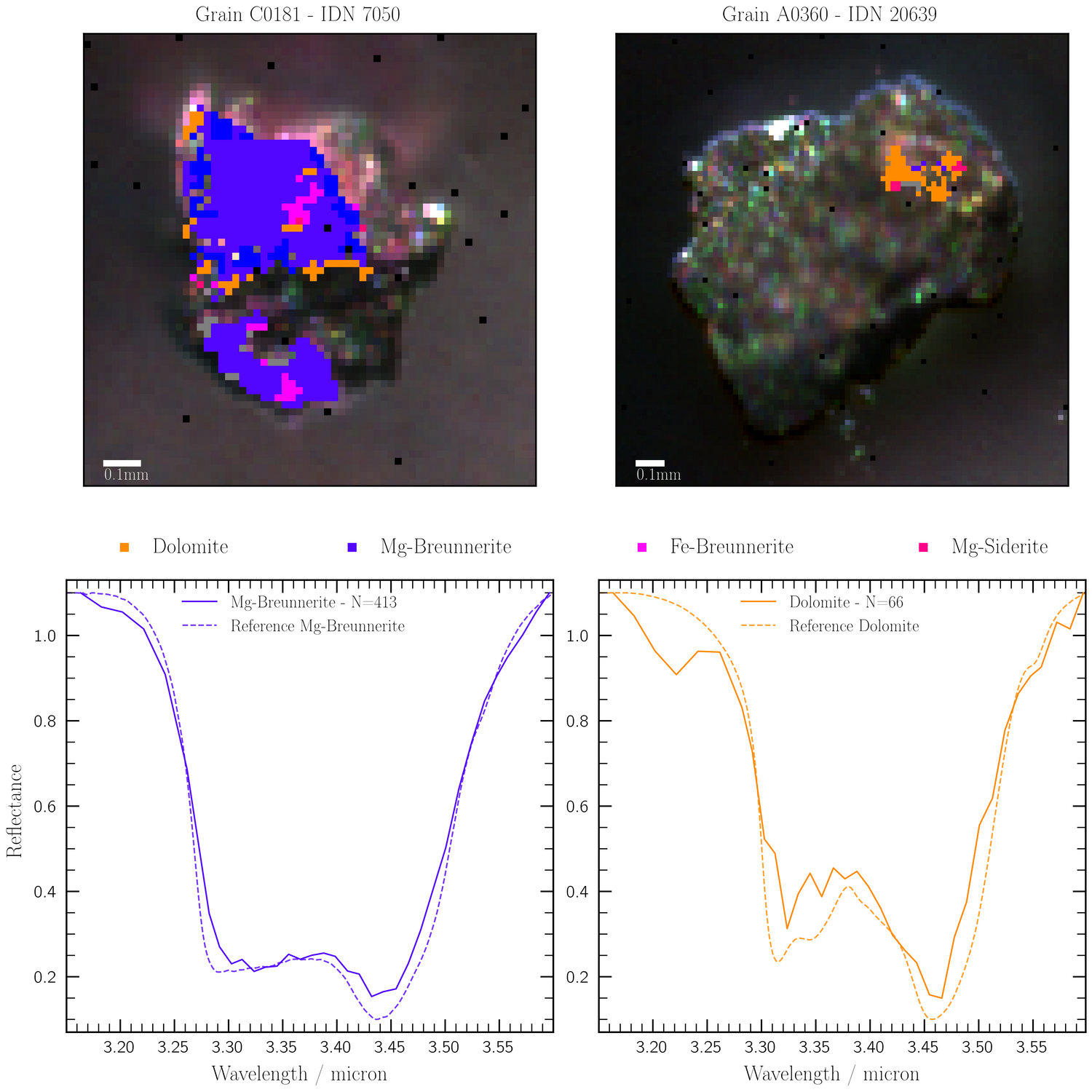Aqueous alteration of Ryugu's parent body: Insights from carbonates seen by MicrOmega
- 1Institut d’Astrophysique Spatiale, Université Paris-Saclay, CNRS, Orsay, France
- 2Institute of Space and Astronautical Science, Japan Aerospace Exploration Agency, Sagamihara, Japan
- 3Marine Works Japan, Ltd, Yokosuka Japan
Carbonate minerals are tracers of the chemical and temporal evolution of aqueous alteration on the parent bodies of meteorites, in particular of the hydrated CI and CM carbonaceous chondrites. While principal differences in the carbonate abundances of CI and CM chondrites representative of different alteration scenarios are well established [1, 2], detailed timelines concerning e.g. the variability in the composition of the alteration fluid and the physical conditions on the parent bodies during alteration remain open questions and require further investigations.
The samples of (162173) Ryugu returned by the JAXA Hayabusa2 mission show similarities with CI chondrites [3, 4]. Thanks to the MicrOmega instrument in the Extraterrestrial Curation Center in Sagamihara, Japan [5, 6], Loizeau et al. [7] identified areas enriched in carbonates in more than 180 Ryugu grains, showing that, consistent with CI chondrites, dolomite-like and breunnerite-like are the most abundant, while the relative abundance between the two depends on the size of the carbonate inclusion. Fujiya et al. [8] reported the presence of rare and small calcite grains in Ryugu, in combination with anhydrous silicates (olivine and Mg-rich pyroxene), indicating that less aqueous alteration occurred in these regions. Using O and C isotopes, they conclude that calcites precipitated first among the carbonates. Yamaguchi et al. [9] further report oscillatory zoning of Mn, Fe, and Ca in dolomites, indicating varying fluid compositions during carbonate formations.
The hyperspectral microscope MicrOmega is in the unique position of analysing the entire returned material of Ryugu under a controlled N2-purged environment within the ISAS, JAXA, curation facility. This enables us to perform a large-scale, statistical description of mineral distributions in the sample. MicrOmega obtains spectra from 1-3.6μm in a 256x256 pixel grid with a spatial pixel scale of 22.5μm. We present here the distribution of carbonates in over 50% of the Ryugu sample in terms of mass, with a focus on small-scale variability (tens of microns, refer to Fig. 1) within carbonates. A particular emphasis is placed on the identification of calcites, given their established link to pristine lithologies in CI chondrites and on Ryugu [2, 8]. Our results show that carbonates follow different compositional distributions between the two chambers A and C, the former representing Ryugu surface material and the latter material excavated via an impactor. We explore different hypotheses concerning the origin of this discrepancy in the chambers' carbonates.

Fig. 1: Top: False-RGB images of carbonate-rich regions on grains C0181 and A0360, colour-coded by the best-matching carbonate references. C0181 is rich in breunnerite-like inclusions, while carbonates in A0360 are predominantly dolomite-like. Carbonates in C0181 show indications of Fe-zoning from the interior to the exterior regions of the inclusion. Bottom: The average spectrum of the breunnerite-like (left) and dolomite-like (left) pixel in C0181 and A0360 respectively (solid lines), together with the best-matching reference spectrum (faded line). N gives the number of pixel matched to the respective best-matching reference spectra.
A more recent addition to the collection of pristine asteroidal material on Earth are the samples of (101955) Bennu collected by NASA’s OSIRIS-REx mission and returned in September 2023. While initially suspected to be of CM-like composition [10], the analysis of bulk major and trace elements suggests that Bennu consists of CI-like material [11]. Unlike for Ryugu, remote-sensing data indicates the presence of large-scale carbonate veins on Bennu’s surface, showing relative species-abundances typical for CM chondrites, with calcite, dolomite, and magnesite as predominant carbonates [12]. At small scales on the returned sample, several carbonate species (e.g. dolomite, calcite, and breunnerite) have been identified [13]. We conclude with an outlook on MicrOmega’'s analyses of Bennu samples, scheduled for delivery by NASA to JAXA in August 2024. This delivery presents an excellent opportunity to compare Bennu and Ryugu samples using a consistent instrumental and experimental setup at ISAS, laying the groundwork for a direct comparison of Ryugu and Bennu in the near future.
References:
[1] Lee, M. R. et al. (2014) Geochim. Cosmochim., 144, 126-156.
[2] Endreß, M. and Bischoff, A. (1996) Geochim. Cosmochim., 60, 489-507.
[3] Yokoyama T. et al. (2023), Science 379, 786.
[4] Nakamura, T. et al. (2023), Science 379, 8671
[5] Bibring, J.-P. et al. (2017), Astrobiology, 17, 621-626.
[6] Pilorget, C. et al. (2022), Nature Astronomy, 6, 221-225
[7] Loizeau, D. et al. (2023), Nature Astronomy, 7, 391–397
[8] Fujiya, W. et al. (2023), Nature Geoscience, 8, 675-782
[9] Yamaguchi, A. et al. (2023), Nature Astronomy, 4, 398-405
[10] Hamilton, V. E. et al. (2019) Nat. Astron. 3, 332-340.
[11] Koefoed, P. et al. (2024), LPSC2024,
[12] Kaplan H. H. et al. (2020) Science, 370.
[13] Thomas-Keprta, K. et al. (2024), LPSC2024
How to cite: Mahlke, M., Lantz, C., Pilorget, C., Bibring, J.-P., Aléon-Toppani, A., Baklouti, D., Brunetto, R., Hatakeda, K., Jiang, T., Loizeau, D., Okada, T., Yada, T., and Yogata, K.: Aqueous alteration of Ryugu's parent body: Insights from carbonates seen by MicrOmega, Europlanet Science Congress 2024, Berlin, Germany, 8–13 Sep 2024, EPSC2024-174, https://doi.org/10.5194/epsc2024-174, 2024.